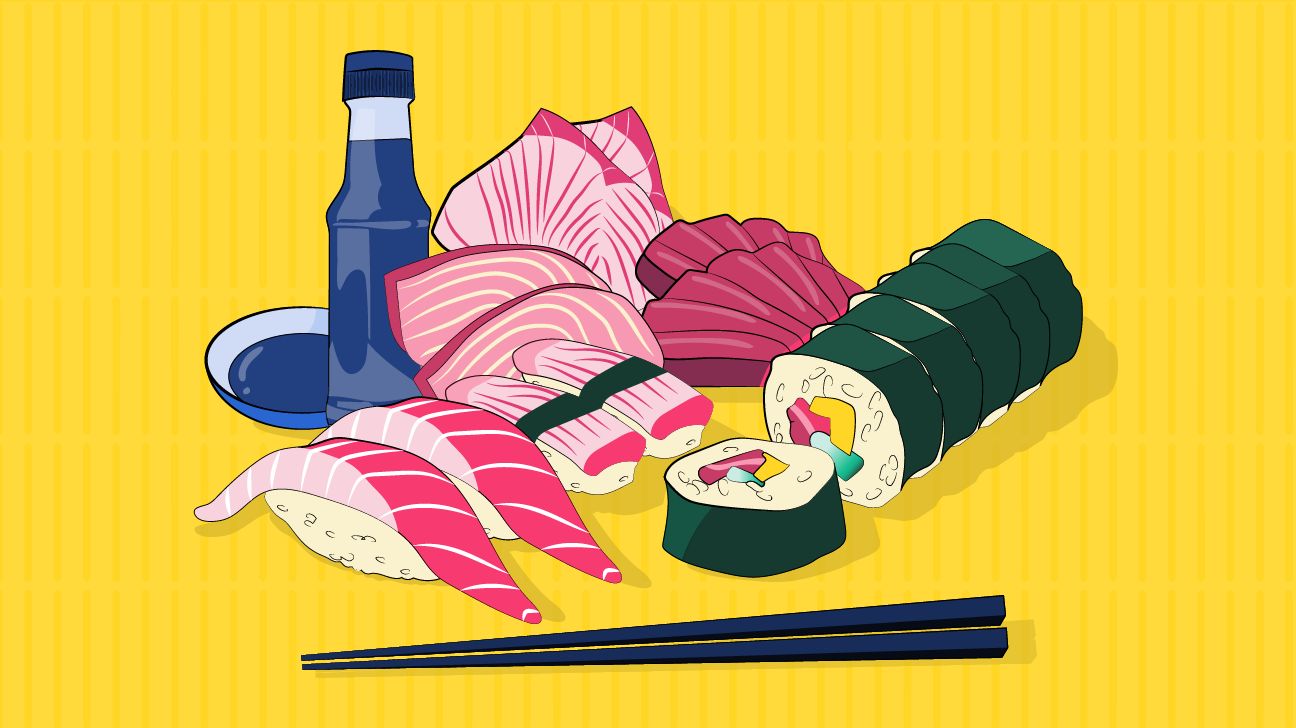
Sushi is truly a delicacy. It’s delicious (so many flavors!), it’s beautiful (so many colors and shapes!), and it’s full of Japanese tradition. The beauty of sushi is in its freshness and simplicity — but for a sushi newbie, unfamiliar words (what’s uramaki?) and etiquette questions (chopsticks versus hands?) can seem intimidating.
Fear not! If you’re ready to open your culinary horizons to the goodness that is sushi, here’s everything you need to know: basics, how to navigate the menu, do’s and don’ts, and the proper way to eat rolls on rolls.
While “sushi” has become a colloquial term for bite-size nomz rolled up with seaweed and rice, it technically refers to just the sticky, vinegared rice. “Sashimi” refers to the raw fish. For the purposes of this Crash Course, we’ll use “sushi” in the colloquial sense, but consider yourself schooled!
If you haven’t yet dabbled in sushi because eating a sliver of raw fish, TBH, scares you, here are two facts to ease your mind:
1. Not all sushi contains raw fish. Some rolls have cooked ingredients, and others contain only veggies, like avocado, sweet potato, or cucumber.
2. Sushi-grade fish is far fresher and of a higher grade than a regular old cut of salmon from the grocery store. Sushi chefs take great pride in using the freshest ingredients and often fly their fish in overnight.
Opening up a menu and not recognizing your options can be overwhelming. Before you make a restaurant rezzie (or order takeout), brush up on some Japanese terminology to get familiar with what you’re ordering (and eating).
Maki: Rolled, cut sushi. This is the most common and most widely recognized type, often showing up in grocery stores as well.
Uramaki: Rolled, cut sushi with rice on the outside of the seaweed (aka “inside-out roll”)
Sashimi: Sliced raw fish, often dipped in variety of sauces, from soy sauce to vinegar-based sauces
Nigiri: Sliced raw fish served over a little bit of rice
Nori: Seaweed, which is wrapped around the ingredients and/or rice
Shoyu: Soy sauce
Wasabi: Japanese horseradish — the green paste served on the side of your order with pickled ginger. It’s extremely spicy and is an acquired taste, so less is more to start!
Tempura: Fish or vegetables that are lightly fried in batter. Tempura can be eaten solo or incorporated into rolls.
Just about any kind of fish can be used in sushi. Some of the more popular ones you’ll find on a menu: sake (salmon), unagi (eel), ebi (shrimp), kani (crab), hamachi (yellowtail), maguro (tuna), and masago (smelt roe) — no one knows what a smelt is, but their eggs are orange and delicious.
And don’t be afraid to order using the Japanese names for fish. No one will laugh at you for showing effort!
Indulging in a special roll piled high with unidentified ingredients can be intimidating to a sushi novice. A slice of raw salmon may also make you wary. When introducing yourself to soosh, start easy with these popular and more basic rolls (some featuring cooked ingredients), which you’ll find on most sushi menus:
California roll: Real or imitation crab (cooked!), avocado, and cucumber
Philadelphia roll: Salmon, avocado, and cream cheese
Boston roll: Cooked shrimp, avocado, and cucumber
King crab roll: Cooked king crab and mayo
Shrimp tempura roll: Fried shrimp with crunchy battered flakes
Vegetable rolls: An array of either raw or cooked veggies and fruits, like carrots, shiitake mushrooms, cucumber, spinach, avocado, and mango
Sushi is typically eaten with a pair of chopsticks, which, truthfully, take some practice to master. Whatever you do, don’t rub wooden chopsticks together like you’re trying to start a fire at the table — it’s rude and implies you think the food is poor-quality.
Eating sushi with your hands is also completely acceptable (even in a restaurant). If you’re not comfortable with either of those options, there is zero shame in asking your server for a fork.
When your plate arrives, you’ll be presented with your sushi of choice, a dollop of wasabi, and thin slivers of pickled ginger. What’s next, you ask? Here are some step-by-step guidelines for eating sushi the traditional way for the best flavor experience:
- Pour just a touch of soy sauce into a dish and dip one piece of sushi, fish side in. Rice is a sponge, and giving your food a brown sodium bath ruins everything.
- If you like heat and bold flavor, use a chopstick to graze the top of the sushi with wasabi — but don’t add too much, or you’ll mask the fish’s delicate sweetness.
- Put the sushi in your mouth and chew it completely to bask in all the flavors. Sashimi and small nigiri rolls should be eaten in one bite, while large Americanized rolls from the special menu may require a few bites.
- Take a sip of sake.
- Eat a piece of pickled ginger. Its mild flavor will cleanse your palate and prepare your mouth for your next bite, which is especially important if you ordered a variety of rolls. Contrary to popular belief, you’re not supposed to top your sushi with ginger.
- Repeat steps 1 to 5 until you’re OMG so full.
Pro tip: Grab a seat at the sushi bar
Making and rolling sushi is an art form that takes an incredible amount of skill and training — that’s why sushi chefs take such pride in what they do. As a beginner, there’s no better way to learn about sushi than to get in on the action and watch the pros at work!
When you sit at the sushi bar, you can watch the chef make your meal and even directly ask them questions. If you’re feeling adventurous but don’t know what you like, ask what special ingredients they’re offering that day. Or ask for omakase, which means “to trust the chef,” giving them the creative power to make something unique for you. (Just be prepared to pay for whatever comes your way.)



